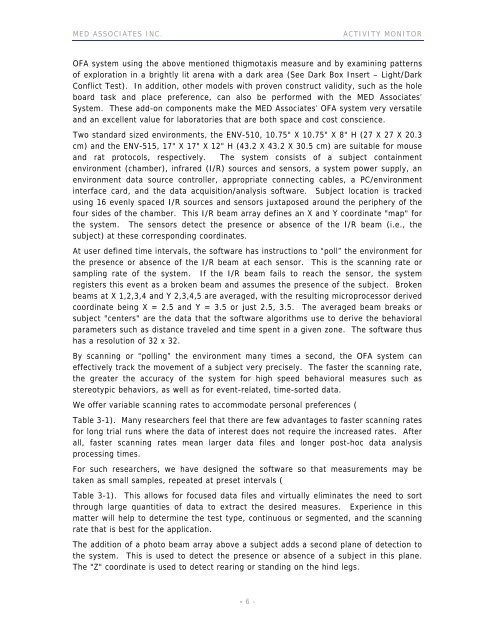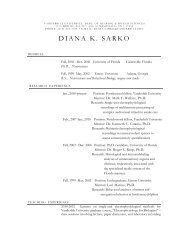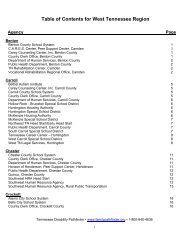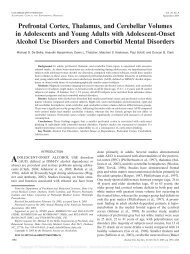ACTIVITY MONITOR - Vanderbilt Kennedy Center
ACTIVITY MONITOR - Vanderbilt Kennedy Center
ACTIVITY MONITOR - Vanderbilt Kennedy Center
Create successful ePaper yourself
Turn your PDF publications into a flip-book with our unique Google optimized e-Paper software.
MED ASSOCIATES INC. <strong>ACTIVITY</strong> <strong>MONITOR</strong><br />
OFA system using the above mentioned thigmotaxis measure and by examining patterns<br />
of exploration in a brightly lit arena with a dark area (See Dark Box Insert – Light/Dark<br />
Conflict Test). In addition, other models with proven construct validity, such as the hole<br />
board task and place preference, can also be performed with the MED Associates’<br />
System. These add-on components make the MED Associates’ OFA system very versatile<br />
and an excellent value for laboratories that are both space and cost conscience.<br />
Two standard sized environments, the ENV-510, 10.75" X 10.75" X 8" H (27 X 27 X 20.3<br />
cm) and the ENV-515, 17" X 17" X 12" H (43.2 X 43.2 X 30.5 cm) are suitable for mouse<br />
and rat protocols, respectively. The system consists of a subject containment<br />
environment (chamber), infrared (I/R) sources and sensors, a system power supply, an<br />
environment data source controller, appropriate connecting cables, a PC/environment<br />
interface card, and the data acquisition/analysis software. Subject location is tracked<br />
using 16 evenly spaced I/R sources and sensors juxtaposed around the periphery of the<br />
four sides of the chamber. This I/R beam array defines an X and Y coordinate "map" for<br />
the system. The sensors detect the presence or absence of the I/R beam (i.e., the<br />
subject) at these corresponding coordinates.<br />
At user defined time intervals, the software has instructions to “poll” the environment for<br />
the presence or absence of the I/R beam at each sensor. This is the scanning rate or<br />
sampling rate of the system. If the I/R beam fails to reach the sensor, the system<br />
registers this event as a broken beam and assumes the presence of the subject. Broken<br />
beams at X 1,2,3,4 and Y 2,3,4,5 are averaged, with the resulting microprocessor derived<br />
coordinate being X = 2.5 and Y = 3.5 or just 2.5, 3.5. The averaged beam breaks or<br />
subject "centers" are the data that the software algorithms use to derive the behavioral<br />
parameters such as distance traveled and time spent in a given zone. The software thus<br />
has a resolution of 32 x 32.<br />
By scanning or “polling” the environment many times a second, the OFA system can<br />
effectively track the movement of a subject very precisely. The faster the scanning rate,<br />
the greater the accuracy of the system for high speed behavioral measures such as<br />
stereotypic behaviors, as well as for event-related, time-sorted data.<br />
We offer variable scanning rates to accommodate personal preferences (<br />
Table 3-1). Many researchers feel that there are few advantages to faster scanning rates<br />
for long trial runs where the data of interest does not require the increased rates. After<br />
all, faster scanning rates mean larger data files and longer post-hoc data analysis<br />
processing times.<br />
For such researchers, we have designed the software so that measurements may be<br />
taken as small samples, repeated at preset intervals (<br />
Table 3-1). This allows for focused data files and virtually eliminates the need to sort<br />
through large quantities of data to extract the desired measures. Experience in this<br />
matter will help to determine the test type, continuous or segmented, and the scanning<br />
rate that is best for the application.<br />
The addition of a photo beam array above a subject adds a second plane of detection to<br />
the system. This is used to detect the presence or absence of a subject in this plane.<br />
The "Z" coordinate is used to detect rearing or standing on the hind legs.<br />
- 6 -







